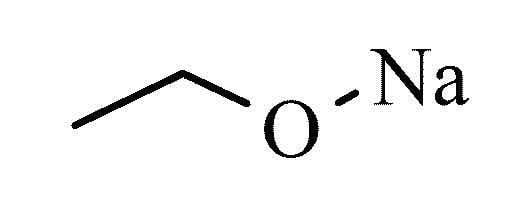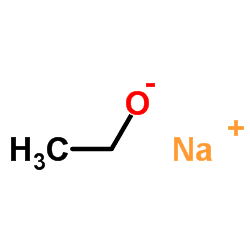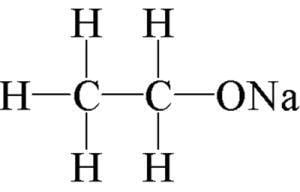Formula C2H5ONa Density 868 kg/m³ | Molar mass 68.05 g/mol | |
 | ||
Appearance white or yellowish powder; hygroscopic | ||
Sodium ethoxide (also is the organic compound with the formula C2H5ONa) is a white to yellowish powder that dissolves in polar solvents such as ethanol. It is commonly used as a strong base.
Contents

Sodium ethoxide
Preparation

Few procedures have been reported to the anhydrous solid. Instead the material is typically prepared in a solution with ethanol. It is commercially available and as a solution in ethanol. It is easily prepared in the laboratory by treating sodium metal with absolute ethanol:
2 C2H5OH + 2 Na → 2 C2H5ONa + H2
An alternative, cheaper route involves the reaction of sodium hydroxide with anhydrous ethanol. This reaction suffers from incomplete conversion to the alkoxide, but for less stringent applications, full conversion is unimportant. The salt product may be purified by precipitation in a solution of anhydrous acetone An improvement to this process involves removing generated water with molecular sieves
Reactions

The solid gradually turns dark on storage in dry air because of oxidation. In moist air, it hydrolyzes rapidly to sodium hydroxide. The conversion is not obvious and typical samples of NaOEt are contaminated with NaOH.
Sodium ethoxide is commonly used in the Claisen condensation and malonic ester synthesis. Sodium ethoxide may either deprotonate the α-position of an ester molecule, forming an enolate, or the ester molecule may undergo a nucleophilic substitution called transesterification. If the starting material is an ethyl ester, trans-esterification is irrelevant since the product is identical to the starting material. In practice, the alcohol/alkoxide solvating mixture must match the alkoxy components of the reacting esters to minimize the number of different products.
Many alkoxides are prepared by salt metathesis from sodium ethoxide.
Safety
Sodium ethoxide is a strong base, and is therefore corrosive.
